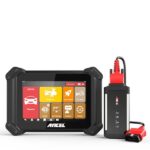Maintaining your vehicle’s transmission is crucial for optimal performance and longevity. Modern vehicles often require a transmission relearn procedure after certain maintenance or repairs to ensure smooth and efficient shifting. This is where an Obd2 Scanner With Transmission Relearn capability becomes an indispensable tool. This article will explore the importance of transmission relearn and how specific OBD2 scanners, like the Xtool D7 and D8 series, can help you achieve this, especially for transmissions like the 6T45 Gen 2.
Understanding Transmission Relearn
The transmission control module (TCM) in your car learns and adapts to your driving style and the wear and tear of the transmission components over time. When you replace parts, perform a transmission service, or even reset the TCM, this learned data can become outdated or irrelevant. A transmission relearn, also known as fast learn or quick learn, is a process that recalibrates the TCM. It allows the module to quickly learn the optimal shift points and pressures with the new or serviced components, preventing issues like harsh shifting, slipping, or incorrect gear engagement. Without this process, your vehicle might not perform as expected after transmission work.
Xtool D7 and D8: Capable OBD2 Scanners for Transmission Relearn
For those looking for an OBD2 scanner with transmission relearn functionality, the Xtool D7 and D8 scan tools are viable options, particularly for vehicles equipped with the 6T45 Gen 2 transmission, commonly found in models like the 2014 GMC Terrain with a 2.4L engine. According to Xtool’s official communication, both the D7 and D8 models are confirmed to support the “Transmission Service Fast Learn” procedure for this specific transmission.
Alt text: Xtool D7 OBD2 Scanner displaying diagnostic information on its color screen, highlighting its capability for transmission relearn and advanced automotive diagnostics.
It’s important to understand the nuances between the different models within the Xtool D7 series, as well as the distinctions between the D7 and D8. While all mentioned models can perform the transmission relearn, the D7 series has variations like D7S and D7W, and the D8 offers additional features.
Xtool D7 Series Variants: D7S vs. D7 vs. D7W
The Xtool D7S is presented as an upgraded version of the base D7 model, and the D7W as a wireless variant of the D7S. Key differences between the D7S and D7 include:
- Protocol Support: The D7S supports CAN FD and DoIP protocols, while the D7 only supports CAN FD. This means the D7S is compatible with newer vehicle communication systems.
- Storage: D7S has 2+64G storage compared to the D7’s 2+32G, offering more space for software and data.
- Camera: D7S includes an 8MP rear camera, which is absent in the D7.
- Kickstand: The D7S has a kickstand for easier hands-free operation, a feature not available on the D7.
- XV100 Compatibility: D7S is compatible with the XV100 videoscope for inspections, while the D7 is not.
- User Interface: D7S features a newer user interface compared to the D7’s older UI, shared with other Xtool products.
- Battery: D7S has a larger 5000mAh battery compared to the D7’s 4000mAh.
- Charging: D7S uses a charging cable, while the D7 uses a USB cable for charging.
- Wired vs. Wireless: The D7W is essentially a wireless version of the D7S, providing greater flexibility in use.
Alt text: Close-up of the Xtool D8 automotive diagnostic tool screen, showcasing its advanced functions and user-friendly interface designed for comprehensive vehicle system analysis and transmission relearn procedures.
D7 vs. D8: Hardware and Functionality Differences
The Xtool D8 is positioned as a step-up from the D7, offering enhanced hardware and broader capabilities. Key distinctions include:
- Hardware: The D8 boasts superior hardware specifications compared to the D7, including a larger screen and battery capacity.
- CAN FD Support: While both support CAN FD, the D8 is mentioned to work directly with CAN FD protocol vehicles, implying potentially better or more robust implementation.
- Advanced Functions: The D8 includes ECU Configuration, ADAS (Advanced Driver-Assistance Systems), and PMI (Programmable Module Installation) functionalities, which are not available in the D7. These features cater to more complex diagnostic and programming tasks.
- Add-ons: The D8 is compatible with add-ons like digital inspection cameras, expanding its utility, whereas the D7 is not.
- Key Programming: The D8 can work with key programmers like KC-100 and KC-501 to enhance its IMMO (Immobilizer) and key programming capabilities, taking it to a more professional level compared to the D7.
- Special Functions: The D8 offers 38 commonly used special functions, slightly more than the D7’s 36.
Choosing the Right OBD2 Scanner for Transmission Relearn
When selecting an OBD2 scanner with transmission relearn for your needs, consider the following:
- Vehicle Compatibility: Ensure the scanner is compatible with your vehicle’s make, model, and transmission type. Xtool D7 and D8 are confirmed for 6T45 Gen 2 transmissions.
- Features and Functionality: Determine if you need advanced features beyond transmission relearn, such as ECU configuration, ADAS, or key programming. The D8 offers a broader range of capabilities compared to the D7 series.
- Budget: The D7 series and D8 likely come at different price points. Consider your budget and the features you require.
- Ease of Use: Both D7 and D8 are designed to be user-friendly, but consider the interface and overall user experience, especially if you are not a professional mechanic.
Conclusion
For ensuring smooth shifting after transmission service, an OBD2 scanner with transmission relearn capability is essential. The Xtool D7 and D8 series are confirmed to be capable tools for this purpose, especially for 6T45 Gen 2 transmissions. Understanding the differences between the D7, D7S, D7W, and D8 models will help you choose the right scanner to meet your specific diagnostic and maintenance needs. By using a suitable OBD2 scanner, you can confidently perform transmission relearn procedures and maintain the optimal performance of your vehicle’s transmission system.
